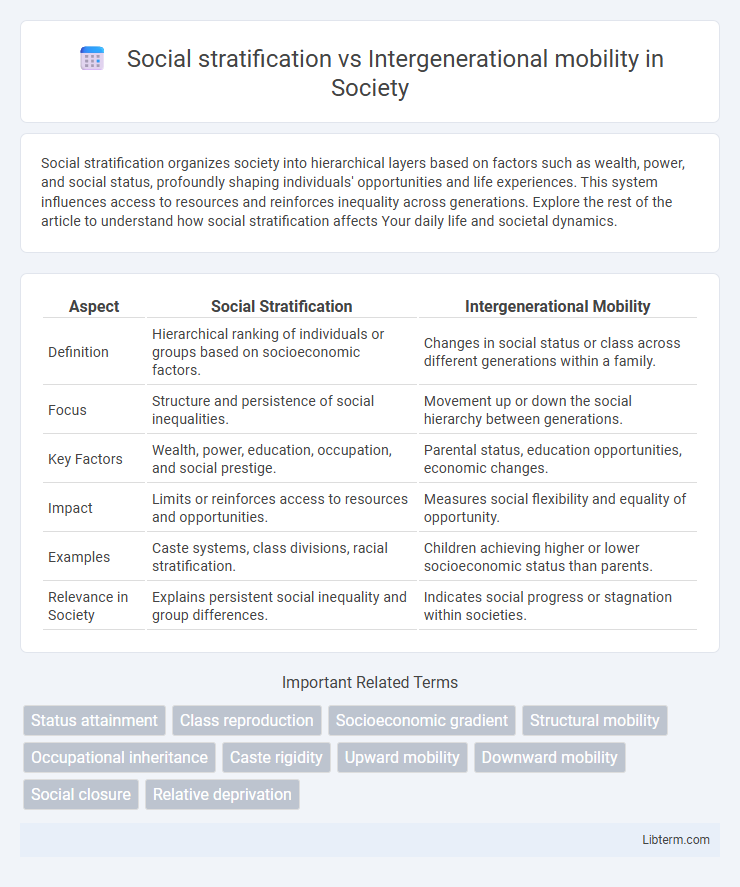Social stratification organizes society into hierarchical layers based on factors such as wealth, power, and social status, profoundly shaping individuals' opportunities and life experiences. This system influences access to resources and reinforces inequality across generations. Explore the rest of the article to understand how social stratification affects Your daily life and societal dynamics.
Table of Comparison
| Aspect | Social Stratification | Intergenerational Mobility |
|---|---|---|
| Definition | Hierarchical ranking of individuals or groups based on socioeconomic factors. | Changes in social status or class across different generations within a family. |
| Focus | Structure and persistence of social inequalities. | Movement up or down the social hierarchy between generations. |
| Key Factors | Wealth, power, education, occupation, and social prestige. | Parental status, education opportunities, economic changes. |
| Impact | Limits or reinforces access to resources and opportunities. | Measures social flexibility and equality of opportunity. |
| Examples | Caste systems, class divisions, racial stratification. | Children achieving higher or lower socioeconomic status than parents. |
| Relevance in Society | Explains persistent social inequality and group differences. | Indicates social progress or stagnation within societies. |
Understanding Social Stratification
Social stratification refers to the hierarchical arrangement of individuals or groups in a society based on factors such as wealth, power, education, and occupation. This system creates structured inequalities that influence life chances, access to resources, and social status across generations. Understanding social stratification involves analyzing how economic disparities, cultural capital, and institutional biases contribute to persistent social layers and limit intergenerational mobility.
Defining Intergenerational Mobility
Intergenerational mobility refers to the changes in social status or class that occur from one generation to the next within a family, highlighting the movement between socioeconomic strata over time. This concept contrasts with social stratification, which examines the rigid hierarchical divisions existing within a society at any given moment. Understanding intergenerational mobility provides key insights into the fluidity of social structures and the potential for upward or downward movement across generations.
Historical Contexts of Social Hierarchies
Social stratification refers to the systematic ranking of individuals into hierarchical social layers based on factors such as wealth, power, and prestige, historically evident in caste systems of ancient India and feudal Europe's rigid class structures. Intergenerational mobility measures the degree to which individuals move between social strata relative to their parents, with limited mobility characterizing societies entrenched in hereditary privilege and ranks, such as the aristocracies before the Industrial Revolution. Historical contexts reveal that societies with pronounced social hierarchies often exhibited low intergenerational mobility due to institutionalized barriers including legal restrictions, inheritance laws, and access to education.
Key Theories Explaining Stratification
Social stratification is often explained through key theories such as functionalism, which argues that social inequality serves a purpose by ensuring that the most qualified individuals fill essential roles, and conflict theory, which views stratification as a result of power struggles and economic inequality between classes. Intergenerational mobility, the ability of individuals to move between social strata from one generation to the next, is influenced by structural factors highlighted in these theories, including access to education, wealth distribution, and social capital. Symbolic interactionism also contributes by examining how individual interactions and societal perceptions reinforce class distinctions and impact mobility opportunities.
Factors Influencing Intergenerational Mobility
Intergenerational mobility is influenced by factors such as education quality, family socioeconomic status, and access to economic resources, which shape individuals' ability to improve their social standing relative to their parents. Social stratification systems, including class, race, and gender hierarchies, often limit mobility by creating structural barriers to equal opportunities. Policies promoting equal access to education and economic participation can mitigate these barriers and enhance upward mobility across generations.
Education’s Role in Mobility and Stratification
Education serves as a critical mechanism influencing social stratification by shaping access to resources and opportunities across different social classes. It significantly affects intergenerational mobility, where higher educational attainment can enable individuals to move beyond the socioeconomic status of their family background. Disparities in educational quality and access often reinforce existing social hierarchies, limiting upward mobility for marginalized groups.
Economic Inequality and Its Impacts
Social stratification creates rigid economic classes that limit intergenerational mobility by restricting access to education, employment, and wealth accumulation. Economic inequality entrenches disparities, resulting in fewer opportunities for lower-income families to improve their socio-economic status across generations. Persistent inequality contributes to a cycle where income and wealth gaps hinder social advancement, impacting social cohesion and overall economic growth.
Social Policies: Reducing or Reinforcing Divides
Social policies play a critical role in either reducing social stratification or reinforcing it by influencing intergenerational mobility rates. Progressive welfare programs, equitable education funding, and labor market regulations promote upward mobility by providing disadvantaged groups with resources and opportunities. Conversely, policies favoring the wealthy, underfunded public services, and discriminatory practices entrench socioeconomic divides and limit mobility across generations.
Case Studies: Mobility Across Different Societies
Studies of social stratification reveal persistent hierarchical divisions based on factors like class, ethnicity, and education that shape individuals' socioeconomic status in societies such as India's caste system and the United States' racial disparities. Intergenerational mobility varies significantly, with Nordic countries exhibiting high rates due to robust welfare and educational opportunities, while countries with rigid class structures like Brazil demonstrate low mobility influenced by entrenched economic inequalities. Comparative case studies highlight how policy frameworks, cultural norms, and historical legacies determine the degree of social mobility achievable across generations worldwide.
Bridging Stratification and Mobility for Social Progress
Social stratification creates persistent inequalities by assigning individuals to social tiers based on factors like wealth, education, and occupation, while intergenerational mobility measures the extent to which individuals can change their social status relative to their parents. Bridging stratification and mobility is crucial for social progress, as it requires reducing structural barriers that limit access to quality education, employment opportunities, and social networks. Enhancing mobility through equitable policies fosters a more inclusive society where talents from all backgrounds contribute to economic growth and social cohesion.
Social stratification Infographic

 libterm.com
libterm.com